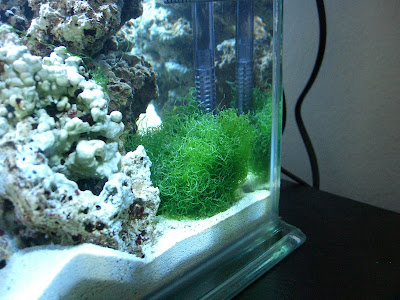I decided to recruit two blue leg hermits to go along with the one I already have and three nassarius snails which are known for their habit of consuming detritus and decaying organics. Nassarius snails like to bury themselves in the sand which will help maintain adequate oxygen levels in the substrate. The blue leg hermits on the other hand are great for keeping down algae and sifting through the sand.

Acclamating the nassarius snails (left) and the blue leg hermit crabs (right) by floating the bag for fifteen minutes. While some people employ a long process with water drips, I find these specimens to be pretty hardy enough to be readily tossed in the tank.

The hermits congregating shortly after being thrown in the tank while the snails scoped out their places...



Another addition to the tank is a ball of chaetomorpha. Chaeto is a type of macroalgae commonly used as additional filtration as it removes phosphates and nitrates from the water. In doing this, chaeto can also prevent the growth of undesirable algae in the tank by using up the nutrients needed by the algae. Like most macroalgae they are commonly placed in an outside filter box or in a separate refugium sump.

In large tanks, a separate sump can serve as a refugium where heaters, protein skimmers and other filter devices can be kept without cluttering the display tank. A deep sand bed can also be kept in a refugium for added biological filtration as well as macroalgae like chaeto and serve as a protected breeding ground for copepods and amphipods which are a food source for certain types of fish. Considering the size of my tank, a refugium is out of the question though some people have rigged power filter boxes into small ones. I however, want to keep a simple minimalist approach to this setup without having to add external sumps and extra lighting.
I placed a clump of chaeto in the rear right corner of the tank where it is tucked away yet it can still receive the sufficient lighting that it needs. It's also in the spot where the power filter and the powerhead intakes are located so it receives good circulation but not so much turbulence that would otherwise scatter it all over the tank.

Notice from the top how this spot is conveniently concealed:

With its fast growth rate, the only thing I have to make sure is to tumble and harvest it regularly to keep it from taking over the tank and getting everywhere. In return, it will help maintain stability in my tank.
Today's Expenses:
- Chaetomorpha bunch: $10 (with plenty of leftovers)
- (2) Blue leg hermit crabs: $3.80 ($1.90 each)
- (3) Nassarius snails: $4.50 ($1.50 each)
TOTAL COST: $18.30

No comments:
Post a Comment